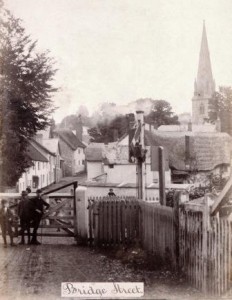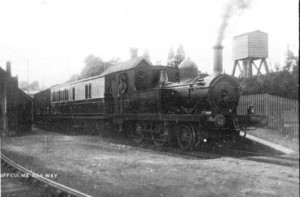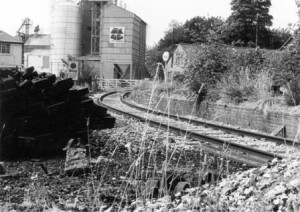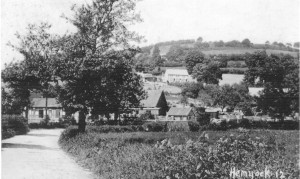 Picture of railway crossing at Bridge Street, Uffculme, Devon. Undated.
Picture of railway crossing at Bridge Street, Uffculme, Devon. Undated.
Railway crossing at Bridge Street
Uffculme Railway

Standing at Uffculme
This picture of a steam train standing at Uffculme is undated.
The quality of the image makes it very difficult to find clues – unless of course you are an expert on the Culm Valley Railway.
Do you know anything about this train? If so, please tell us.
Lloyd Maunder Animal Feed

Railway lines heading towards Lloyd Maunder feed mill in Uffculme
The Culm Valley Railway lines heading towards the feed mill at Uffculme. We have contacted Lloyd Maunder to see if they can offer us any help on establishing some more information about this photo. They seemed very helpful when we called them and we await their reply.
We know the family business began in 1898, although Lloyd’s father, FJP Maunder, was in the meat trade around 1879, in Witheridge, Devon.
Some more about their history can be found on the Lloyd Maunder website.
History Group Speaker – 14 April 2011
The Hemyock History and Archiving Association’s Speaker of the Month for April 2011, has been confirmed.
Amyas Crump will talk on ‘East Devon’s railway heritage’.
This will be in the form of a slide show using mostly 1960’s colour film from several photographers who visited the area during the last years of steam working. It will include the Exe Valley, Main line, Tiverton or ‘Tivvy’ Bumper, Westleigh Tramway and of course, the Culm Valley.
Amyas says of himself: “Having been born on the wrong side of the hill – in Ford Street – an early birthday outing to see off the last train from Hemyock, sparked a lifelong interest in our railway history. Later, through the recovery of Brunelian type trackwork from Burlescombe, this interest extended into industrial railway archeology. With the demise of so much of our rail network and those who knew it, a film and relic archive has been built up which is now used for exhibitions, publishing and slide shows.
The Archives will be adding some pictures of railway scenes, later. The impact the railways had on the local history in the region has been most important to the community. This talk will be of great interest to a good cross section of people.
Recent talks have seen standing room only – we’d expect more of the same for this speaker’s fayre, so please arrive early to get a good seat – front facing, of course.
The ‘journey departs’ at 7:30pm at the Church Rooms, Hemyock. Parking is limited, so please try and use the local amenities free car park near the village hall (140 yard walk), to allow those with reduced mobility to get ‘that bit closer’. As always, the small silent army of volunteers will be brewing light refreshments from the buffet car. No calls for ‘tickets please’ but donations are taken for the up-keep of the Church Rooms.
For more information or to join the mailing list, please contact Mike Cooper on 01823 680175 or via our Contact Us page.
Station Road Bridge
A view from the bottom of Station Road looking across the river, towards Hemyock Railway Station and part of the old Milk Factory. After this picture was taken, a small wooden bridge was installed (by the Milk Factory) to enable the public easier access accross the River Culm when it was flooded.
In March 2011, the ‘original’ wooden footbridge (which would have been on the right-hand side of the road in this picture) was removed following the opening of a new wooden footbridge on the opposite side of the road.
Click on the picture to see the location and how it looks, in more recent times.
Do you know anything about the subject matter in this image?
We would welcome your knowledge or interesting facts or stories.
You can help us build this archive by adding your knowledge to the records. Just follow the
3 simple steps.
- Click on ‘Leave a comment’
- Type in your name and email address. If you have a website that is relevant tothe purposes of the archives, you can add it here also.
- Click the ‘Post Comment’ button and your comments will be added to thewebsite.
See a short tutorial on how to add comments.
Why bother?
These archives are managed by the Hemyock History and Archiving Association (HH&AA). The organisation is an unincorporated charity and relies on volunteers, contributions and grants to continue its work.
By adding your comments, you are contributing in two ways.
- You are adding valuable reference material to a community run project, whichmight otherwise be lost or missed. This means that even the smallest detail of information will be captured for future generation. This is a massive project and many hands make light work.
- Your information will form part of the website. This means that search engines,such as Google, Bing and Yahoo! will be able to add this information to their search results. Your contribution might just mean a long lost relative being able to find their family history, from anywhere in the world.

